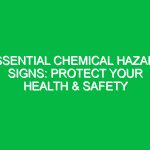Introduction
Understanding the meaning of chemical Hazards is crucial in the Health, Safety, and Environment (HSE) sector. Chemical Hazards refer to substances that can cause harm to human health or the environment due to their chemical properties. The significance of grasping this concept cannot be overstated, as it lays the foundation for effective risk management and Safety protocols in workplaces that handle hazardous chemicals. In this article, we will explore the various dimensions of chemical hazard meaning, examine key aspects related to HSE, and provide actionable insights to enhance Safety Standards.
Defining Chemical Hazard Meaning
Chemical hazard meaning encompasses the potential risks associated with chemical substances that can cause adverse Effects. These hazards can manifest in various forms, including toxicity, flammability, corrosiveness, or reactivity. Understanding these properties enables organizations to implement appropriate Safety Measures, ensuring the well-being of employees and minimizing environmental impact.
Chemical hazards can be categorized into several types:
- Toxic Hazards: Chemicals that can cause illness or death upon exposure.
- Flammable Hazards: Substances that can ignite easily and cause Fires.
- Corrosive Hazards: Chemicals that can damage living tissue or material upon contact.
- Reactive Hazards: Substances that can undergo a chemical reaction that releases energy or creates hazardous byproducts.
Recognizing these categories is essential for creating a safe working environment and ensuring compliance with safety Regulations.
Key Aspects of Chemical Hazards in HSE
To effectively manage chemical hazards, it is important to understand their key aspects within the HSE framework. Here are some essential components:
1. Risk Assessment
Risk assessment involves evaluating the potential hazards associated with chemical substances in the workplace. This process includes identifying the chemicals used, assessing their properties, and determining the likelihood of exposure. It is vital to consider factors such as the duration of exposure, the method of exposure (inhalation, skin contact, etc.), and the population at risk.
2. Material Safety Data Sheets (MSDS)
Material Safety Data Sheets (MSDS) are critical documents that provide detailed information about hazardous substances. They include data on chemical properties, health hazards, safe handling Procedures, and emergency measures. Employers should ensure that MSDS are readily accessible to employees and that workers are trained on how to interpret and use this information effectively.
3. Personal Protective Equipment (PPE)
Personal Protective Equipment (PPE) plays a vital role in protecting workers from chemical hazards. Depending on the type of chemical and the nature of the work, appropriate PPE may include gloves, goggles, respirators, and protective clothing. Employers must assess the risks involved and provide the necessary equipment, along with proper Training on its use and Maintenance.
4. Training and Education
Training is an integral component of chemical hazard management. Employees must be educated about the hazards they may encounter, safe handling practices, and emergency response procedures. Regular training sessions can reinforce safety protocols and ensure that workers are aware of updated regulations and Best Practices.
Identifying and Mitigating Chemical Hazards
Recognizing potential chemical hazards is the first step in mitigation. Here are some strategies to identify and control these risks effectively:
1. Regular Inspections
Conducting routine inspections of the workplace can help identify unsafe conditions and practices. Inspections should include checking storage areas for proper labeling, assessing ventilation systems, and ensuring that safety equipment is functional and readily available.
2. Implementing Engineering Controls
Engineering controls are methods designed to eliminate or reduce exposure to chemical hazards. This can include installing fume hoods, using closed systems for chemical handling, or improving ventilation in areas where hazardous substances are used. These measures often provide a more sustainable solution to hazard management compared to relying solely on PPE.
3. Establishing Emergency Response Plans
Having a comprehensive emergency response plan is vital for minimizing the impact of chemical incidents. This plan should outline procedures for dealing with spills, exposure incidents, and fires. Regular drills and updates ensure that employees know how to react promptly and effectively in an emergency situation.
Real-Life Examples and Case Studies
To illustrate the importance of understanding chemical hazard meaning, consider these examples:
Case Study 1: The Bhopal Disaster
The Bhopal disaster in India in 1984 is one of the most notorious industrial accidents in history. A leak of methyl isocyanate gas from a pesticide plant resulted in thousands of deaths and long-term health consequences for survivors. This tragedy underscores the critical need for understanding chemical hazards and implementing robust safety systems to prevent similar incidents.
Case Study 2: Chemical Spill in a Laboratory
In a university laboratory, a student accidentally spilled a volatile solvent. Due to proper training and immediate access to emergency response procedures, the lab team quickly contained the spill and evacuated the area. This incident highlights the effectiveness of training, preparedness, and the importance of a well-structured safety culture in managing chemical hazards.
Regulations and Standards Governing Chemical Hazards
Various regulations and standards govern chemical hazards to ensure Workplace Safety. Key regulations include:
- Occupational Safety and Health Administration (OSHA): osha sets forth standards for hazardous chemicals, requiring employers to develop a Hazard Communication Program.
- Environmental Protection Agency (EPA): The EPA regulates chemical substances to protect human health and the environment, enforcing compliance with the Toxic Substances Control Act.
- Globally Harmonized System (GHS): The GHS provides a consistent approach to classifying chemicals and communicating hazard information through labeling and safety data sheets.
These regulations play a crucial role in shaping chemical hazard meaning within the HSE context, guiding organizations in their safety practices and compliance efforts.
Best Practices for Managing Chemical Hazards
To promote a culture of safety regarding chemical hazards, organizations should adopt the following Best Practices:
1. Develop a Chemical Safety Program
A comprehensive chemical safety program should encompass all aspects of managing chemical hazards, including risk assessments, training, and emergency response procedures. It should be regularly reviewed and updated as necessary.
2. Foster a Safety Culture
Encouraging open communication about safety concerns and empowering employees to speak up can significantly enhance Workplace Safety. Management should actively promote safety initiatives and recognize employees for their commitment to Safe Practices.
3. Continuous Improvement
Safety is an ongoing process. Organizations should regularly review their safety practices, stay updated on new regulations, and invest in training and resources to improve their chemical hazard management strategies continually.
Conclusion
In conclusion, unlocking the meaning of chemical hazards is essential for ensuring safety in the workplace and protecting the environment. By understanding the potential risks associated with chemical substances, organizations can implement effective risk management strategies to safeguard employees and promote compliance with regulations. The importance of training, regular inspections, and establishing a strong safety culture cannot be overstated. As we move forward, it is crucial for businesses to remain vigilant and proactive in their approach to chemical hazard meaning, fostering a safer and more sustainable future for all.


